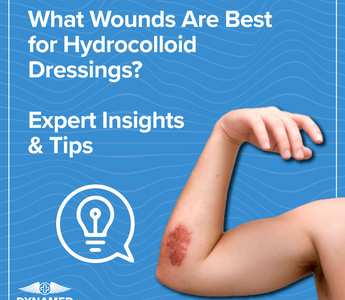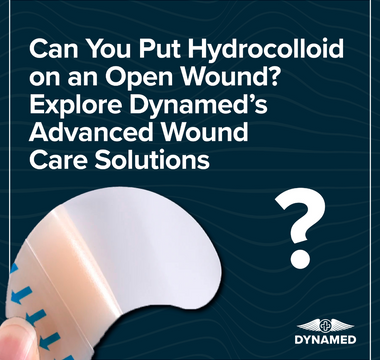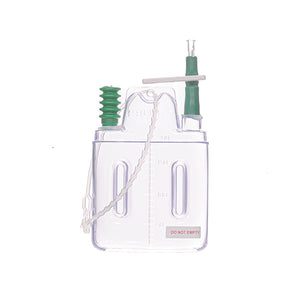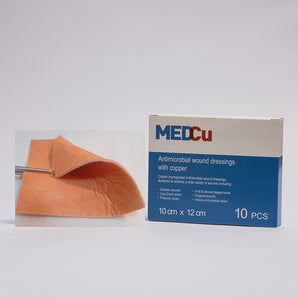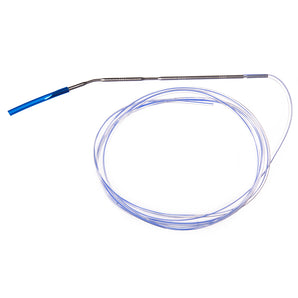Navigating the world of wound care can be daunting, especially when it comes to choosing the right dressing for optimal healing. Hydrocolloid dressings have emerged as a reliable choice, offering a moist environment that aids in effective recovery. But what types of wounds benefit most from this innovative solution?
Hydrocolloid dressings are particularly effective for managing pressure ulcers, venous ulcers, and post-surgical wounds. Their ability to form a cohesive gel upon contact with exudate helps maintain a moist microenvironment, crucial for promoting healing. Additionally, these dressings provide a barrier against bacteria, reducing the risk of infection.
Understanding which wounds respond best to hydrocolloid dressings allows us to make informed decisions in wound management. By recognising their strengths in handling low to moderate exudate, we can enhance recovery and improve overall health outcomes. Let's explore how these dressings can transform the healing process for specific wound types.
Key Takeaways
-
Hydrocolloid dressings are ideal for managing low to moderate exudate wounds such as pressure ulcers, venous ulcers, minor cuts, abrasions, blisters, and post-surgical wounds.
-
These dressings maintain a moist environment crucial for effective healing, facilitating faster cell regeneration by forming a cohesive gel with wound exudate.
-
They act as a protective barrier against bacteria, thus reducing the risk of infection and providing a cushioning effect to alleviate pain.
-
Despite their benefits, hydrocolloid dressings are not suitable for heavily exudative or infected wounds, where alternative dressings may be required.
- Proper application and care, including wound cleaning and monitoring, are vital for ensuring optimal outcomes with hydrocolloid dressings.
Understanding Hydrocolloid Dressings
Our approach to wound care at Dynamed includes hydrocolloid wound dressings as a cornerstone, offering advanced solutions for healing. These dressings cater to various wound types, including pressure ulcers and post-surgical wounds, contributing to effective recovery processes.
Composition and Mechanism
Hydrocolloid dressings consist of a combination of gel-forming agents such as gelatin, pectin, and carboxymethylcellulose. Upon contact with wound exudate, they form a cohesive gel that maintains a moist environment. This gel ensures the wound remains hydrated, fostering cells' optimal healing conditions. As it turns into a gel, the dressing provides cushioning, reducing discomfort for the patient. Our design guarantees sterility and conformability, making it suitable for difficult-to-dress areas.
Benefits of Hydrocolloid Dressings
Hydrocolloid dressings offer several benefits in wound care:
-
Moist Environment: They create a sealed barrier that enhances healing by preserving moisture.
-
Bacterial Protection: The dressing's impermeable nature blocks water and bacterial entry, minimizing infection risks.
-
Pain Alleviation: By padding the wound, they reduce pain during the healing process.
- Long-Lasting: Capable of adhering for days, they lessen the frequency of dressing changes, which is convenient and cost-effective.
By understanding these attributes, our advanced wound care solutions, like hydrocolloid dressings, play a vital role in managing and healing wounds. Interested in exploring our products further? Visit Dynamed's website for more information on our offerings.
Types of Wounds Suitable for Hydrocolloid
In the world of healthcare, the key to recovery often lies in the smallest details, like the right bandage or ointment. At Dynamed, South Africa's foremost name in wound care and medical devices, we've got a knack for tackling these details. From basic wound care products to sophisticated medical devices, our offerings aim to simplify and enhance the healing process.
But what's the secret behind effective wound care, and how can our products make a difference in your healthcare journey? Let's take a closer look.
Understanding Hydrocolloid Wound Dressings
Hydrocolloid wound dressings are like those behind-the-scenes heroes in advanced wound care. They're specially designed to maintain a moist environment, promoting faster healing. Our hydrocolloid dressings form a cohesive gel when they come in contact with wound exudate, keeping the area hydrated and protected.
Types of Wounds Suitable for Hydrocolloid
Minor Cuts and Abrasions
Ever had a cut or scrape that seemed small yet stubborn to heal? These minor wounds often benefit from our hydrocolloid dressings. This dressing ensures quick recovery by keeping the wound moist and cushioned, thus speeding up cell regeneration. Given its ability to adhere well, it's especially useful in hard-to-dress areas, providing a lasting cover without frequent changes.
Pressure Ulcers
Pressure ulcers, sometimes known as bedsores, can be particularly challenging. Fortunately, our hydrocolloid dressings offer an effective solution by maintaining a healing environment that reduces friction and pressure. When managing these ulcers, it's critical to use a dressing that can effectively manage exudate while maintaining skin integrity, which our product excels at.
Blisters and Burns
For those pesky blisters and burns, our dressings provide a protective barrier while keeping the affected area comfortable. The cushioning effect ensures minimal pain, making life that bit more bearable as the skin recovers. Plus, its bacterial barrier reduces the risk of infection, helping keep the healing process on track.
Tips & Tricks for Effective Wound Care
-
Clean the Area: Always start by cleaning the wound site with sterile water or saline solution.
-
Apply the Dressing: Gently place the dressing over the wound, ensuring it covers the entire area securely.
- Monitor: Regularly check the wound without removing the dressing unless necessary. Changes should be based on the specific needs of the wound, not a strict schedule.
Advanced Wound Care Insights
Using the right products is essential, but how they're used greatly affects outcomes. For instance, while hydrocolloid dressings are brilliant for certain wounds, we also offer complementary products like hydrogel wound dressings when extra hydration is needed. Each dressing type serves a unique purpose, and effective wound care involves knowing which to choose and when.
Advantages of Using Hydrocolloid Dressings
Hydrocolloid dressings, integral to advanced wound care, cater to various wound types with unique benefits. They're a go-to option in wound management due to their versatility and effectiveness.
Moisture Retention
Hydrocolloid dressings excel in moisture retention by creating a moist microenvironment essential for wound healing. When these dressings interact with wound exudate, they form a cohesive gel which keeps the wound surface hydrated, promoting cell growth. This feature dramatically accelerates the natural healing process and reduces the risk of scabbing, which can delay recovery. Moreover, by maintaining an optimal level of moisture, hydrocolloid dressings minimise the need for frequent dressing changes, benefiting both caregivers and patients.
Bacterial Barrier
These dressings offer a reliable barrier against bacteria and contaminants, thus lowering infection risks. Their impermeable nature stops external elements from reaching the wound, keeping it safe from infection while still enabling gas exchange. In many cases, this bacterial barrier is crucial for delicate wounds like pressure ulcers and minor burns, which are susceptible to infections if left exposed. Ensuring the wound is protected not only aids in faster recovery but also provides peace of mind to patients concerned about potential complications.
We encourage trying different wound care options, like silver or hydrogel wound dressings, if needed. Visit our website at dynamed.co.za to explore more about our advanced wound care products.
Limitations and Considerations
Hydrocolloid dressings play a vital role in advanced wound care, yet it's crucial to understand their limitations. Though beneficial for numerous wound types, certain scenarios call for alternative products.
When Not to Use Hydrocolloid
While versatile, hydrocolloid wound dressings aren't suitable for heavily exuding wounds. Large amounts of exudate may overwhelm the dressing, leading to maceration of the surrounding skin. Additionally, highly infected wounds may require antimicrobial dressings such as those incorporating silver, which provide enhanced bacterial management. For wounds where visibility is needed, like those monitored for infection or healing progress, hydrocolloids may obscure the view due to their opaque nature.
Potential Side Effects
Despite their benefits, hydrocolloid dressings may cause skin irritation in sensitive individuals. Allergic reactions, though rare, can occur from prolonged contact with the dressing's adhesive components. A dressing that remains in place extendedly without proper monitoring might promote hypergranulation.
While hydrocolloid wound dressings from Dynamed Pharmaceuticals provide effective solutions for many wounds, they aren't a one-size-fits-all remedy. Understanding their appropriate use ensures optimal outcomes in advanced wound care.
Tips for Application and Care
Applying and caring for hydrocolloid dressings is crucial for effective wound healing. Let's explore some essential tips to ensure optimal usage and maintenance.
-
Clean the Wound: Thoroughly cleanse the wound area using saline solution or an appropriate wound cleansing agent. This removes debris and reduces the risk of infection.
-
Select the Right Size: Choose a hydrocolloid dressing that extends 2 cm beyond the wound edges. This ensures complete coverage and enhances adherence to the surrounding skin.
-
Warm the Dressing: Before application, hold the dressing between your hands for a few seconds. This improves flexibility and helps it conform better to the wound site.
-
Secure Application: Peel away the backing and gently place the dressing over the wound without stretching it. Firmly press the edges to secure it in place.
-
Monitor the Site: Inspect the wound around the dressing for signs of leakage, maceration, or infection. Change the dressing every 3-7 days or when exudate approaches the edge.
-
Remove Gently: To prevent skin damage, peel off the dressing slowly, starting from the corners. If adhesion is strong, moisten the edges and gradually lift.
- Dispose Properly: Place used hydrocolloid dressings in a sealable bag before disposal in accordance with local regulations for medical waste.
For further resources on wound care products and advanced wound care, visit Dynamed Pharmaceuticals. Remember, while hydrocolloid dressings offer many advantages, they're not suitable for all wound types. Consider consulting a healthcare professional to tailor care to specific needs.
Conclusion
Hydrocolloid dressings stand out as a versatile and effective solution in wound care, especially for pressure ulcers, venous ulcers, and post-surgical wounds. Their ability to maintain a moist environment and provide protection against bacteria makes them invaluable. However, it's crucial to recognise their limitations, such as their unsuitability for heavily exuding or highly infected wounds. By choosing the right dressing and following proper application techniques, we can significantly enhance healing outcomes. Always consider consulting a healthcare professional for tailored advice to ensure the best care for each unique wound situation.
Dynamed Pharmaceuticals
Phone: 0861 00 00 43
Website: dynamed.co.za
Email (Sales): sales@dynamed.co.za
Email (Info): info@dynamed.co.za
Google Maps: Find us here
Frequently Asked Questions
What are hydrocolloid dressings?
Hydrocolloid dressings are advanced wound care products made from gel-forming agents like gelatin, pectin, and carboxymethylcellulose. When applied to a wound, they interact with the wound's exudate to form a gel, creating a moist microenvironment that promotes healing, offers bacterial protection, and reduces pain.
Which wounds are suitable for hydrocolloid dressings?
Hydrocolloid dressings are ideal for minor cuts and abrasions, pressure ulcers, blisters, and burns. They're beneficial for wounds that require a moist environment to heal, though unsuitable for wounds with heavy exudation.
How do hydrocolloid dressings promote healing?
These dressings create a moist environment by forming a gel upon contact with wound exudate. This sustains hydration, accelerates healing, and reduces dressing change frequency, while cushioning the wound and providing a barrier against bacteria.
Are there any limitations to using hydrocolloid dressings?
Yes, hydrocolloid dressings are not suitable for heavily exuding or highly infected wounds. They may lead to skin maceration if overused and can obscure visibility of the wound, complicating monitoring for infection or healing progress.
How frequently should hydrocolloid dressings be changed?
Hydrocolloid dressings typically need changing every 3-7 days. It's important to monitor the wound for signs of leakage or infection. Changes should be gentle to prevent skin damage and ensure proper disposal of used dressings.
Can hydrocolloid dressings cause any side effects?
Some potential side effects include skin irritation and allergic reactions. Monitoring for signs of hypergranulation or irritation is crucial. If adverse reactions occur, contacting a healthcare professional is advised to avoid further complications.
Why should one consult a healthcare professional before using hydrocolloid dressings?
Consulting a healthcare professional ensures appropriate wound care tailored to individual needs. They can determine the suitability of hydrocolloid dressings or recommend complementary products like hydrogel dressings for optimal hydration and healing.

